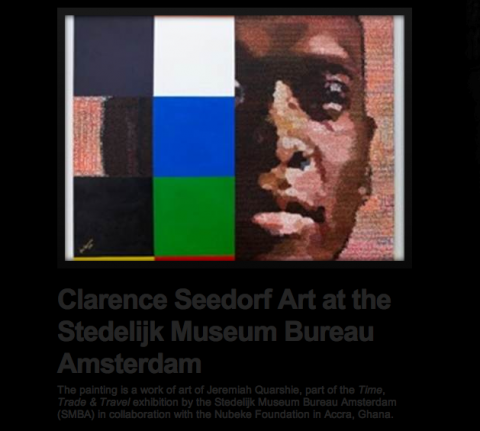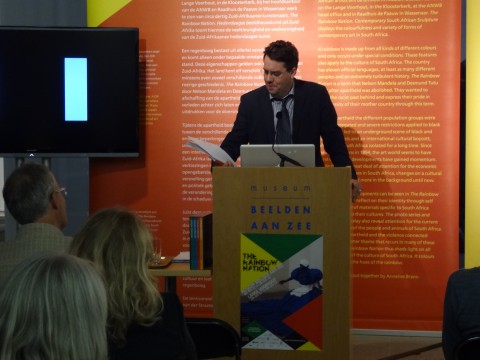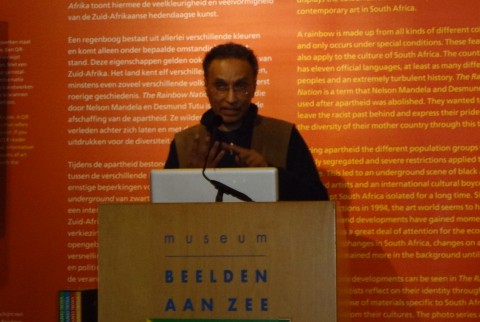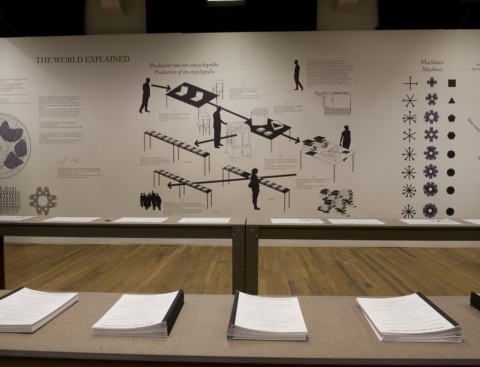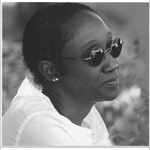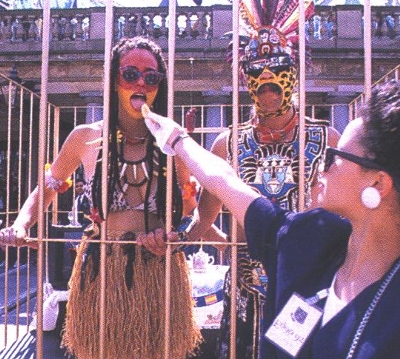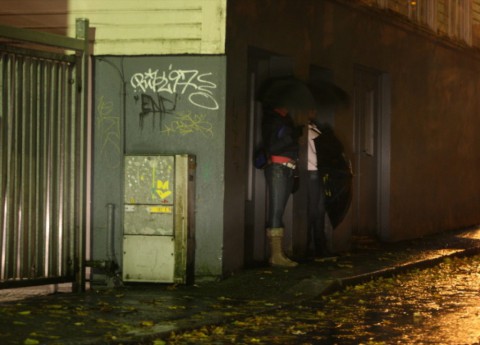Soccer player Clarence Seedorf responds to the work of Jeremiah Quarshie on his personal website. As part of the exhibition ‘Time, Trade and Travel’ at Stedelijk Museum Bureau Amsterdam, Quarshie presents ‘This is who I am?’ (2012), including a portrait of Seedorf as a reference to postcolonial identity.
Click here to download SMBA Newsletter #129 and to read more on the work of Jeremiah Quarshie.
This summer the Dutch Museum Beelden aan Zee curated ‘Rainbow Nation’, an exhibition of contemporary South African sculptures. In the final weekend the symposium ‘Mixing the Colors of the Rainbow’ was organised, to discuss the current status of South African art and art history. Head of exhibitions Dick van Broekhuizen started the evening with a short introduction to ‘Rainbow Nation’. To provide a contextual framework guest curator Annelies Brans-Van der Straeten referred to the historical time line of the new art historical encyclopaedia ‘Visual Century. South African Art in Context 1907-2007’. Editors of ‘Visual Century’ Gavin Jantjes and Lize van Robbroeck were invited to explain the realization of this historical overview and the accompanying struggles with methodology. Dutch art historian and curator Esther Schreuder was invited to present her view on South African art history.
More
Book presentation January 19, Rijksakademie Amsterdam
Report by Madelon van Schie
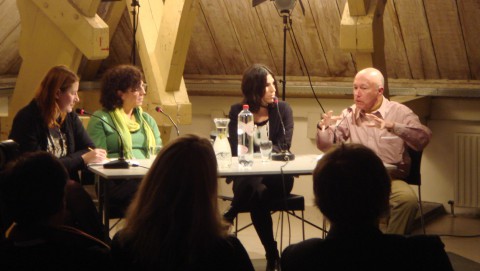
Book presentation Making Art Global, roundtable discussion with Annie Fletcher, Rachel Weiss, Direlia Lazo and Gerardo Mosquera.
The book presentation of Making Art Global (Part 1): The Third Havana Biennial 1989, with contributions by Rachel Weiss, Luis Camnitzer, Coco Fusco and Geeta Kapur ao, formed part of the program Temporary Stedelijk 3-Stedelijk@Rijksakademie and was organized in collaboration with publisher Afterall Books. Introduced by Annie Fletcher, editor Rachel Weiss and curator Gerardo Mosquera pointed out the groundbreaking aspects of the third Havana Biennial and clarified its context in two presentations and a roundtable discussion in which independent curator Direlia Lazo participated as well.
More
Mexican artist Erick Beltrán presents his project ‘The World Explained’ at Tropenmuseum Amsterdam. It consists of a large collection of interviews with so-called ‘non-experts’ on how the world functions. With a small team of anthropologists Beltrán interviewed people in Sao Paulo, Barcelona and Amsterdam. The conversations were recorded and transcribed and finally collected into an ‘Encyclopedia’, which visitors could take home. The accompanying maps and diagrams on the wall emphasise Beltrán’s theory on the production of knowledge as a local-based phenomenon.
‘The World Explained’ is on view until March 11. Click here to read a report in Dutch.
More
By publishing the Project ‘1975’ essay ‘The Politics of Exclusion’, SMBA presented an introduction to the range of problems connected to the definition of African Art. Author Rikki Wemega-Kwawu is certainly not alone in his criticism towards the current discourse of African and Global art. In addition the Nigeria-born American Sylvester Okwunodu Ogbechie, Associate Professor Art History at the University of California Santa Barbara, criticizes the ‘Eurocentric’ definition of contemporary art and the idea of ‘global contemporary’ in his article ‘Where is Africa in Global Contemporary Art?’ in Savvy Journal.
Okwunodu Ogbechie argues: ‘My estimate is that there are less than one thousand “Contemporary African artists” who live and work in the West although they account for 99 % of all artists included in international exhibitions of Contemporary African Art.’
Comparable to Wemega-Kwawu’s argument, Okwunodu Ogbechie states that the aspects of ‘transnational interaction’, to travel and communicate internationally, seem to be crucial in the definition of contemporary art. Yet, who has the facilities to perform this transnational interaction? And are the concepts of place, location and site-specific history of any value to the definition of African art? Click here to read Sylvester Okwunodu Ogbechie’s article ‘Where is Africa in Global Contemporary Art?’ in the online version of Savvy Journal (page 24-31).
While Project ‘1975’ researches the relation between international contemporary art and the postcolonial discourse, Former West reflects upon the changes introduced to the world (and thus to the so-called West) by the political, cultural, artistic, and economic events of 1989.
The fall of the Berlin wall in 1989 represented the end of the Cold War between the communist East and the capitalist West, and represented the end of an era (or even ‘the end of history’ in the words of Francis Fukuyama). The term “former West,” the unofficial counterpart to the widely used “former East,” refers to this division. How have the events in 1989 influenced the dichotomy? What has changed since then? And what is it that we have in mind when we now speak of the “East” and the “West?”
These are the questions initiator Maria Hlavajova (artistic director of BAK, basis voor actuele kunst, Utrecht) and co-organisor Charles Esche (director Van Abbemuseum, Eindhoven) formulated during the introduction of the first research congress in 2009.
More
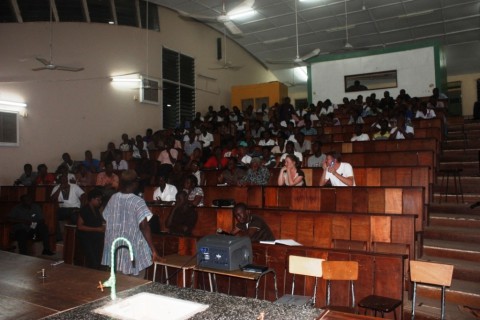
Kari-kacha Seid'ou, art teacher, introduces Bouwhuis and Winking to the students of the College of Art / KNUST, Kumasi, Ghana.
In the week of October 27th, Jelle Bouwhuis and Kerstin Winking travelled to Ghana to meet with artists, as part of the exchange programme organised by SMBA and the Nubuke foundation in Accra. After their visit to Accra, they travelled to Elmina, Takoradi and Kumasi.
In Takoradi they met painter Rikki Wamega-Kwaku, who they requested to write a contribution for the next SMBA Newsletter. The College of Art of the Kwame Nkumrah University of Science & Technology invited Bouwhuis and Winking to visit Kumasi and to give a lecture on SMBA and contemporary curating. Furthermore several studio visits were organised to meet with several artists and art students.
Besides Ghana, Bouwhuis and Winking also travelled to Bamako (Mali), to attend the opening of the Bamako Encounters, the Biennale for African photography. One of the promising artists they met in Mali, Abdoulaye Konaté, might be part of a future exposition at SMBA.
Click here to read Bouwhuis’ review on the Bamako Encounters Biennale for Nafas Art Magazine.
Tate and Guaranty Trust Bank announced an important new partnership which will broaden Tate’s international reach to Africa, provide a platform for African artists to be seen by audiences world-wide and heighten awareness of the impact of African art on modern and contemporary practice. The legacy and current influence of art produced in areas outside Europe and North America has been a focus for Tate in recent years and this presents an unprecedented opportunity to examine Africa’s role at the heart of global artistic developments. The partnership will involve the creation of a dedicated curatorial post at Tate Modern to focus on African art, an Acquisition Fund to enable the Gallery to enhance its holdings of work by African artists and an annual project.
Chris Dercon, Director Tate Modern said:
“This important partnership between Tate and GTB marks the recognition of the significance of modern and contemporary art in Africa. We now have an unprecedented opportunity to work with colleagues in the region, with energy, curiosity and eagerness, to define new parameters in art. This is the beginning of being able to give African art the focus it deserves with audiences around the world.“
Click here to read the press release on the website of Tate Modern
Journalist Wim Bossema wrote a report about the art scene in Ghana for the Dutch newspaper De Volkskrant. Bossema met the internationally known and successful artist Kofi Setordji, and spoke to him about his new project in which he combines applied arts (and design) with fine arts. For this project, Setordji collaborated with the Nubuke Foundation. Furthermore Bossema discusses the paintings and installations of the Nigerian artist Akirash and the tradition of the highlife music genre in the 1960s and 1970s, which loses popularity due to the current curfew-order.
Click here to read Wim Bossema’s Dutch article ‘In Ghana ligt kunst op straat’.
The Nubuke Foundation’s Kofi Setordji and Odile Tevie visited the Stedelijk Museum Bureau Amsterdam, thanks to the support of the Prins Claus Fund. Stedelijk Museum Bureau Amsterdam is preparing a cultural exchange programme with Ghana, in which Netherlands-based artists and Ghana-based artists will meet and exchange knowledge, skills and experiences. The Nubuke Foundation plays an important role in the production of this Project 1975 exchange programme.
Click here to read more about the Nubuke Foundation and follow this Project 1975 blog to learn more about the cultural exchange programme.
George Osodi is an artist who has taken the relation between Europe and Africa as a point of departure. The work of the Nigerian-born Osodi, whom most will know from his participation in Roger Buergel’s documenta 12, tells about the effects of globalisation on people’s lives with great empathy: his art concerns Africa, but it also accentuates the continent’s involvement in transnational processes.
Click here to read Kerstin Winking’s article ‘The Ethical Revolution’ on the work of George Osodi.

The exhibition GEO-graphics. A Map of Art Practices in Africa, Past and Present is the largest part of the Visionary Africa festival in the Bozar Center for Fine Arts in Brussels, held on the occasion of the 50th anniversary of the independence of the Democratic Republic of Congo and 16 other African countries. It is also the first stage in a four-year collaboration between the art center and the Royal Museum of Central Africa in Tervuren, that characteristic museum of colonial museology that will soon be subjected to reconstruction and expansion.
Click here to read the full review ‘The many ambitions of GEO-graphics’ on the website of Nafas Art Magazine.
In a review for Nafas Art Magazine, Jelle Bouwhuis and Kerstin Winking discuss the ninth edition of the Dak’Art Biennial. Unlike the other editions, the exhibition was now divided into an international and a retrospective part. This latter part consisted of works of artists who won the Grand Prix Leopold Sedar Senghor, amongst others Mounir Fatmi (2006), Viyé Diba (1998) and also the late Moustapha Dimé. Because of this retrospective emphasis, the international part of the exhibition was a small presentation of only 27 artists. However, the work of the 2010 Senghor Award, the Congolese-living in France Moridja Kitenge Banza, was memorable, Bouwhuis and Winking argue.
Jelle Bouwhuis discusses Hala Elkoussy’s recent work ‘Myths & Legends Room – The Mural’. The work measures three by nine meters, and deals with the reality of life in Cairo, the city that lies at the base of almost all of Elkoussy’s works. Elkoussy produced a collage-landscape out of photographs from several contexts. Artistically, this large mural therefore exploits the ideas of the photomontage that has become ubiquitous through the advertisement industry. However, for a better understanding of the Mural’s creative background, first reference has to be made to commemorative wall paintings such as those in the National Military Museum in Cairo depicting various war scenes from Egypt’s history, the heroism of the military, and its popular support.
Click here to read the full article on the website of Nafas Art Magazine.

